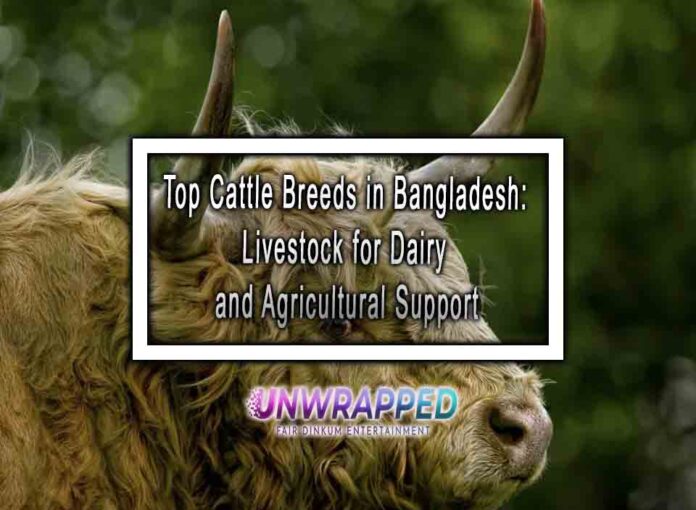Cattle farming is an essential part of Bangladesh’s agricultural sector, supporting rural livelihoods and contributing to the nation’s food security. With a dense population and a predominantly agrarian economy, cattle in Bangladesh are not only valued for milk and meat production but also as draft animals for farming. The tropical climate and small-scale farming practices require breeds that are hardy, productive, and well-suited to local conditions.
This article explores the top cattle breeds in Bangladesh, focusing on their characteristics, uses, and contributions to the country’s agricultural success.
Top Cattle Breeds in Bangladesh
1. Red Chittagong
- Key Characteristics: Red coat, medium frame, and adaptability to tropical climates.
- Primary Use: Dual-purpose (milk and meat production).
- Fun Fact: Red Chittagong is a native breed of Bangladesh, known for its disease resistance and ability to thrive on limited resources, making it ideal for smallholder farms.
2. Pabna Cattle
- Key Characteristics: White or light brown coat, medium size, and high milk yield.
- Primary Use: Dairy production.
- Fun Fact: Originating from the Pabna district, these cattle are known as Bangladesh’s premier dairy breed, producing rich, creamy milk that supports rural dairy farming.
3. Sahiwal
- Key Characteristics: Reddish-brown coat, medium size, and heat tolerance.
- Primary Use: Dairy production and crossbreeding.
- Fun Fact: Imported from South Asia, Sahiwal cattle are popular for their high milk yield and ability to thrive in tropical climates, often used to improve local cattle breeds.
4. Friesian Crossbreeds
- Key Characteristics: Black-and-white coat, large frame, and high milk yield.
- Primary Use: Dairy production.
- Fun Fact: Crossbreeding Friesian cattle with local breeds has enhanced milk production in Bangladesh, creating high-performance dairy cows adapted to the local environment.
5. Brahman
- Key Characteristics: Light gray or red coat, large hump, and loose skin.
- Primary Use: Beef production and draft power.
- Fun Fact: Brahman cattle are highly heat-tolerant and disease-resistant, making them a favorite for beef production in Bangladesh’s tropical conditions.
6. Hariana
- Key Characteristics: White coat, medium frame, and docile temperament.
- Primary Use: Draft power and dairy production.
- Fun Fact: Hariana cattle are commonly used for plowing and transport in rural Bangladesh, while their milk supports small-scale dairy farming.
7. Indigenous Non-Descript Cattle
- Key Characteristics: Small frame, variable coat colors, and hardy nature.
- Primary Use: Multi-purpose (milk, meat, and draft power).
- Fun Fact: These native cattle are often the backbone of smallholder farms, surviving on minimal resources and providing essential agricultural support.
8. Gir
- Key Characteristics: Reddish-white coat, long ears, and a prominent hump.
- Primary Use: Dairy production.
- Fun Fact: Gir cattle, originally from India, are increasingly popular in Bangladesh for their high milk yield and adaptability to humid climates.
9. Crossbred Zebu
- Key Characteristics: Medium size, variable coat colors, and heat tolerance.
- Primary Use: Multi-purpose (milk, meat, and draft power).
- Fun Fact: Crossbreeding Zebu with local cattle improves productivity while maintaining resilience to tropical conditions.
10. Jersey
- Key Characteristics: Light brown coat, small frame, and rich milk production.
- Primary Use: Dairy production.
- Fun Fact: Jersey cows are favored for their butterfat-rich milk, which is ideal for producing ghee and other traditional dairy products in Bangladesh.
Sustainability and Cattle Farming Practices in Bangladesh
- Integrated Farming Systems: Cattle are often raised alongside crops, providing manure for fertilizer and draft power for plowing fields.
- Crossbreeding Programs: Breeding programs aim to enhance milk and meat production by crossbreeding local cattle with high-yielding breeds like Friesian and Sahiwal.
- Feed Management: Farmers use agricultural byproducts like rice straw and banana leaves as cattle feed, reducing waste and costs.
- Community Dairy Farming: Cooperative dairy farming models are gaining popularity, enabling smallholder farmers to pool resources and access better markets.
Interesting Facts About Cattle Farming in Bangladesh
- Smallholder Dominance: Most cattle farming in Bangladesh is done by small-scale farmers, with cattle serving as a primary source of income and nutrition.
- Cultural Importance: Cattle are central to festivals like Eid al-Adha, where they are often used in traditional sacrificial rituals.
- Dairy Growth: The dairy sector in Bangladesh is growing, with government initiatives promoting breeds like Pabna and Sahiwal for higher milk production.
- Adaptation to Climate: Native breeds like Red Chittagong and Pabna are well-suited to Bangladesh’s tropical climate, thriving where imported breeds might struggle.
Frequently Asked Questions
Q: Which cattle breed is best for dairy production in Bangladesh?
A: Pabna cattle are the best for dairy production, while Sahiwal and Friesian crossbreeds are also popular for their high milk yields.
Q: What is the most heat-tolerant cattle breed in Bangladesh?
A: Red Chittagong and Brahman cattle are highly heat-tolerant, thriving in the tropical climate of Bangladesh.
Q: Are there native cattle breeds in Bangladesh?
A: Yes, Red Chittagong and Pabna cattle are indigenous breeds known for their adaptability and productivity.
Q: How do smallholder farmers manage cattle in Bangladesh?
A: Farmers use locally available feed, rely on native breeds, and incorporate cattle into integrated farming systems to maximize efficiency and reduce costs.
Conclusion: Resilient Breeds for a Thriving Sector
Cattle farming in Bangladesh is vital to the country’s agricultural and economic landscape. From the hardy Red Chittagong to the high-yielding Pabna cattle, these breeds provide essential support to millions of smallholder farmers. With a focus on sustainability and productivity, Bangladesh is steadily improving its dairy and beef sectors to meet growing demand.
Whether producing rich milk for traditional sweets or lean meat for local markets, Bangladesh’s cattle breeds embody resilience and adaptability, ensuring a sustainable future for its agricultural industry.
Another Must-Read: Top Cattle Breeds in Malaysia: Perfect Livestock for Meat and Dairy Farming










